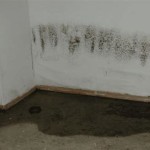Should You Paint Your Basement Ceiling Black? A Comprehensive Guide
Painting a basement ceiling black is a design trend that has gained traction, offering a unique aesthetic alternative to traditional white ceilings. However, the decision to embrace this trend requires careful consideration of various factors, including the specific characteristics of the basement, the desired aesthetic outcome, and potential implications for lighting and overall functionality. This article explores the advantages and disadvantages of painting a basement ceiling black, providing information to help homeowners make informed decisions.
Aesthetic Considerations: Achieving the Desired Look
One of the primary drivers behind painting a basement ceiling black is the aesthetic impact it creates. A black ceiling can visually recede, making the space feel taller and more open, particularly in basements with low ceilings. This effect is due to the optical illusion of depth created by the dark color, blurring the boundary between the ceiling and the upper walls. This can be especially beneficial in basements where minimizing the feeling of confinement is a priority.
Furthermore, a black ceiling can create a dramatic and modern atmosphere. It's often used in contemporary designs to add a touch of sophistication and edge. It works particularly well in entertainment areas, home theaters, or spaces designed for social gatherings. The dark ceiling can also help to create a more intimate and cozy ambiance, contrasting with lighter colored walls and flooring.
The effectiveness of a black ceiling in achieving the desired aesthetic depends heavily on the existing architectural features and the overall design scheme. If the basement has exposed ductwork, pipes, or wiring, painting the ceiling black camouflages these elements, creating a more unified and streamlined appearance. This is often referred to as the "open ceiling" or "industrial" look, where the functionality of the space is celebrated rather than concealed. Conversely, if the intention is to highlight architectural details, a lighter ceiling color might be more suitable.
However, it's crucial to consider the potential for the black ceiling to visually shrink the space if not implemented correctly. In small or poorly lit basements, a black ceiling can exacerbate the feeling of claustrophobia, making the room feel smaller and darker. Therefore, careful planning and consideration of the room's dimensions and natural light availability are essential.
Lighting and Functionality: Balancing Aesthetics with Practicality
The impact of a black ceiling on the lighting and functionality of the basement is a significant consideration. Black surfaces absorb light, which means that less light is reflected back into the room. This can lead to a darker space that requires more artificial lighting to maintain adequate illumination.
Therefore, careful planning of the lighting scheme is paramount when opting for a black ceiling. Recessed lighting, track lighting, and strategically placed lamps are crucial for compensating for the reduced light reflection. The type of light fixtures and the color temperature of the bulbs also play a vital role in creating the desired ambiance and ensuring sufficient brightness.
For example, warmer light bulbs (2700K-3000K) can create a cozy and inviting atmosphere, while cooler light bulbs (3500K-4000K) can provide a brighter and more energetic feel. The choice of light temperature should align with the intended use of the basement space and the overall design aesthetic.
Furthermore, the reflectivity of the paint finish also affects the amount of light reflected. Matte black paint absorbs the most light, while semi-gloss or satin black paints reflect slightly more light. The choice of paint finish should be based on the desired balance between aesthetics and functionality.
It's also important to consider the natural light available in the basement. If the basement has limited or no windows, relying solely on artificial lighting is necessary. In such cases, a black ceiling might not be the ideal choice unless a robust lighting plan is in place. However, if the basement has ample natural light, the impact of a black ceiling on the overall brightness might be less pronounced.
Beyond lighting, functionality extends to maintenance. A black ceiling can reveal dust and imperfections more readily than a lighter ceiling. Therefore, regular cleaning and maintenance are required to keep it looking its best. Choosing a washable paint finish can simplify the cleaning process.
Practical Considerations: Preparation, Application, and Costs
Painting a basement ceiling black involves several practical considerations related to preparation, application, and costs. Proper preparation is crucial for achieving a professional and long-lasting finish.
Before painting, it's essential to thoroughly clean the ceiling to remove any dust, dirt, or cobwebs. This can be done using a vacuum cleaner with a brush attachment or a damp cloth. Any existing stains or blemishes should be addressed with a primer designed to block stains and ensure uniform paint adhesion.
If the basement ceiling has exposed ductwork, pipes, or wiring, it's important to protect these elements with masking tape or plastic sheeting before painting. This will prevent overspray and ensure a clean and professional finish. Additionally, consider using a paint sprayer for a more even and efficient application, especially if the ceiling has a textured surface or numerous exposed elements.
The application process typically involves applying one or two coats of primer followed by two or three coats of black paint. The number of coats required depends on the type of paint used and the desired level of coverage. It's important to allow each coat to dry completely before applying the next.
Choosing the right type of paint is also crucial. Latex paint is a popular choice for basement ceilings due to its durability, ease of application, and low odor. However, it's important to select a paint specifically formulated for ceilings, as these paints are designed to minimize dripping and spattering.
The cost of painting a basement ceiling black can vary depending on the size of the basement, the complexity of the ceiling, and whether the homeowner chooses to hire a professional painter or tackle the project as a DIY endeavor. Hiring a professional painter can ensure a high-quality finish, but it will also increase the overall cost. DIY painting can save money, but it requires time, effort, and attention to detail.
Furthermore, the cost of paint, primer, and other materials should be factored into the overall budget. It's advisable to purchase high-quality paint and materials to ensure a durable and long-lasting finish. Skimping on materials can result in a subpar finish that requires more frequent maintenance or repainting.
Finally, consider the potential for the black ceiling to affect the resale value of the home. While a black ceiling can be a stylish and modern addition, it might not appeal to all prospective buyers. Therefore, it's important to consider the potential impact on resale value before making a final decision. In some cases, it might be advisable to consult with a real estate professional to get their perspective on the local market.
In conclusion, the decision to paint a basement ceiling black requires careful consideration of aesthetic preferences, lighting conditions, functionality requirements, and practical considerations. While a black ceiling can create a dramatic and modern atmosphere, it's important to weigh the advantages and disadvantages before committing to this design trend.

Our Painted Basement Ceiling Black With Photo Examples

Black Painted Ceiling Vs White In Michigan Basements

Our Painted Basement Ceiling Black With Photo Examples

Basement Ceilings Painted Black A Spray Painting Job From Hell

Our Painted Basement Ceiling Black With Photo Examples

Our Painted Basement Ceiling Without A Sprayer And The Perfect Black Paint This Diy Life

Tales Of Painted Basement Ceilings And Pole Dancing Woes Beth Bryan

Basement Ceilings Painted Black A Spray Painting Job From Hell

Our Painted Basement Ceiling Without A Sprayer And The Perfect Black Paint This Diy Life

Basement Ceilings Painted Black A Spray Painting Job From Hell
Related Posts







